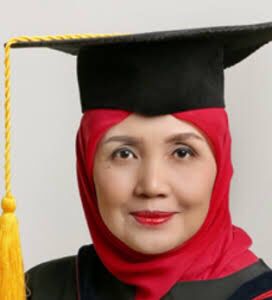Implementation of Virtual Reality-based Electromagnetic Field Learning for Senior High School Students : @SMAN17 (Senior High School 17) Bandung, West Java, Indonesia

The project aims to investigate the performance of implementing virtual reality technology in the context of electromagnetic field learning, with a specific focus on enhancing students' enthusiasm towards the subject matter. The activity is anticipated to stimulate the cognitive processes of students, including critical thinking,creativity, and problem-solving skills. The project covers both Senior High School and Vocational School within the secondary education system in West Java, Indonesia. The project involves encouraging collaboration among the educational institution,university community, and relevant stakeholders. It is important that all students participate in the learning process of acquiring knowledge about electromagnetic fields through the utilization of virtual reality media.
Date and Time
Location
Hosts
Registration
-
 Add Event to Calendar
Add Event to Calendar
- SMAN17 (Senior High School17 Bandung), Jl. Caringin, Babakan Ciparay, Kec. Babakan Ciparay
- Bandung, Jawa Barat
- Indonesia 40223
- Click here for Map
- Contact Event Host
-
bmulyanti@upi.edu
- Survey: Fill out the survey
Speakers
 Budi of Jurusan Pendidikan Teknik Elektro - Fakultas Pendidikan Teknologi dan Kejuruan - Universitas Pendidikan Indonesia
Budi of Jurusan Pendidikan Teknik Elektro - Fakultas Pendidikan Teknologi dan Kejuruan - Universitas Pendidikan Indonesia
Understanding the Concept of Electromagnetic Field: Exploring Virtual Reality as a Learning Media
In this session, the fundamentals of electromagnetic fields are discussed. Students are required to understand the basic concept before using the VR to learn about the EM. An electromagnetic field is made up of interdependent electric and magnetic fields, which is the case when the fields are varying with time, that is, they are dynamic. Meanwhile, Virtual reality allows people to enter a virtual situation created through 3D visual effects, and it uses human senses and immersive equipment to simulate things in real life. In the virtual world, users can see, hear, or touch virtual objects as if situated in the real world, and they can also interact with others in real-time. Therefore, Educational VR environments can be especially beneficial in supporting students learning of such content. For example, electromagnetism or three-dimensional (3-D) statics concepts can be challenging to grasp mentally because such concepts cannot be physically observed.
Biography:
Budi Mulyanti (ID 93362968) is a professor of material physics at the Faculty of Technology and Vocational Education (FPTK), Universitas Pendidikan Indonesia (UPI). She received Ph.D in physics from Institut Teknologi Bandung, Indonesia in 2006. She is a senior member of the Institution of Electrical and Electronics Engineer (IEEE) from 2013. She is also a vice chairman of physics society of Indonesia Bandung Chapter. She is member of National Credit Assessment Team of Republic of Indonesia and also member of National Research Reviewer Republic of Indonesia. She was a head of Department of Electrical Engineering and Education FPTK UPI from 2015 until 2019. She was also head of TVET center FPTK UPI from 2008 until 2010. She was awarded as the best researcher from Universitas Pendidikan Indonesia in 2016. She has published three text books in material electronics for undergraduate courses and more than 50 academic research papers. Her current interests are design and fabrication of photonic devices, bioMEMS, and solar cell development.
Email:
Address:Jalan Dr. Setiabudhi No. 229 , Jurusan Pendidikan Teknik Elektro - Fakultas Pendidikan Teknologi dan Kejuruan - Universitas Pendidikan Indonesia , Bandung, Indonesia, 40154
 Wawan of Jurusan Pendidikan Teknik Elektro - Fakultas Pendidikan Teknologi dan Kejuruan - Universitas Pendidikan Indonesia
Wawan of Jurusan Pendidikan Teknik Elektro - Fakultas Pendidikan Teknologi dan Kejuruan - Universitas Pendidikan Indonesia
Enhancing Students' Critical, Creativity, and Problem-Solving Skills in Electromagnetic Field Learning through VR
The importance of enhancing students' critical, creative, and problem-solving skills is discussed in this session. Critical thinking is inextricably connected to both problem solving and decision making. It always has a goal – usually, to solve a problem or come to a decision. For example, students might apply critical thinking in their science lesson to work out the best way to approach their group project. Enhancing a student’s critical thinking skills is particularly essential in a liberal education model, which believes in teaching students how to think and not what to think. There are some of the reasons why students need critical thinking skills: Enhancing creativity and curiosity; Promoting self-assertion and self-reflection; Nurturing problem-solvers and innovators; and Fostering allied life skills. Through the VR media, it is to be expected the students can improve Critical, Creativity, and Problem-Solving Skills especially in EM field learning.
Biography:
Wawan Purnama. He is a lecturer in the Electrical Engineering Education Study Program, Faculty of Technology and Vocational Education, Universitas Pendidikan Indonesia. He received Master degree in Department of Physics, Institut Teknologi Bandung. His current interests are in the physics of electronic and physics education.
Email:
Address:Jalan Dr. Setiabudhi No. 229 , , Kota Bandung , Indonesia, 40154
Agenda
Agenda : 08:00 - 08:20 : Opening Remark 08:20 - 09:00 : 1st Lecture : Prof Dr Budi Mulyanti : "Understanding the Concept of Electromagnetic Field: Exploring Virtual Reality as a Learning Media" 09:00 - 09:10 : Q & A 09:10 - 09:50 : 2nd Lecture : Wawan Purnama, M.Si : "Enhancing Students' Critical, Creativity, and Problem-Solving Skills in Electromagnetic Field Learning through Virtual Reality Media" 09:50 - 10:00 : Q & A 10:00 - 11:20 : EM Field VR Demonstration and Practice 11:20 - 11:30 : Closing Remark
